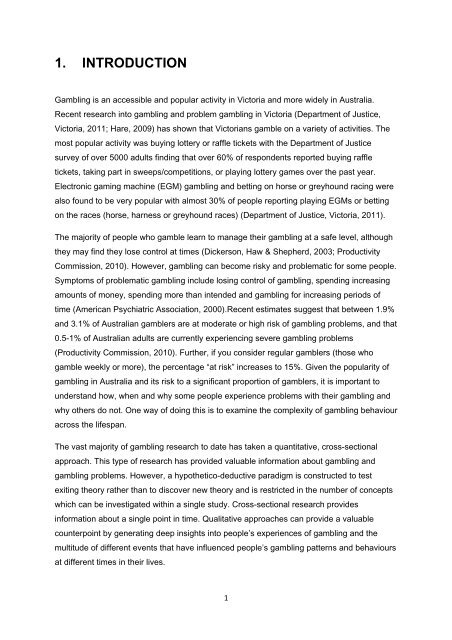Gamblers tell their stories: Life patterns of gambling
Gamblers tell their stories: Life patterns of gambling
Gamblers tell their stories: Life patterns of gambling
You also want an ePaper? Increase the reach of your titles
YUMPU automatically turns print PDFs into web optimized ePapers that Google loves.
1. INTRODUCTION<br />
Gambling is an accessible and popular activity in Victoria and more widely in Australia.<br />
Recent research into <strong>gambling</strong> and problem <strong>gambling</strong> in Victoria (Department <strong>of</strong> Justice,<br />
Victoria, 2011; Hare, 2009) has shown that Victorians gamble on a variety <strong>of</strong> activities. The<br />
most popular activity was buying lottery or raffle tickets with the Department <strong>of</strong> Justice<br />
survey <strong>of</strong> over 5000 adults finding that over 60% <strong>of</strong> respondents reported buying raffle<br />
tickets, taking part in sweeps/competitions, or playing lottery games over the past year.<br />
Electronic gaming machine (EGM) <strong>gambling</strong> and betting on horse or greyhound racing were<br />
also found to be very popular with almost 30% <strong>of</strong> people reporting playing EGMs or betting<br />
on the races (horse, harness or greyhound races) (Department <strong>of</strong> Justice, Victoria, 2011).<br />
The majority <strong>of</strong> people who gamble learn to manage <strong>their</strong> <strong>gambling</strong> at a safe level, although<br />
they may find they lose control at times (Dickerson, Haw & Shepherd, 2003; Productivity<br />
Commission, 2010). However, <strong>gambling</strong> can become risky and problematic for some people.<br />
Symptoms <strong>of</strong> problematic <strong>gambling</strong> include losing control <strong>of</strong> <strong>gambling</strong>, spending increasing<br />
amounts <strong>of</strong> money, spending more than intended and <strong>gambling</strong> for increasing periods <strong>of</strong><br />
time (American Psychiatric Association, 2000).Recent estimates suggest that between 1.9%<br />
and 3.1% <strong>of</strong> Australian gamblers are at moderate or high risk <strong>of</strong> <strong>gambling</strong> problems, and that<br />
0.5-1% <strong>of</strong> Australian adults are currently experiencing severe <strong>gambling</strong> problems<br />
(Productivity Commission, 2010). Further, if you consider regular gamblers (those who<br />
gamble weekly or more), the percentage “at risk” increases to 15%. Given the popularity <strong>of</strong><br />
<strong>gambling</strong> in Australia and its risk to a significant proportion <strong>of</strong> gamblers, it is important to<br />
understand how, when and why some people experience problems with <strong>their</strong> <strong>gambling</strong> and<br />
why others do not. One way <strong>of</strong> doing this is to examine the complexity <strong>of</strong> <strong>gambling</strong> behaviour<br />
across the lifespan.<br />
The vast majority <strong>of</strong> <strong>gambling</strong> research to date has taken a quantitative, cross-sectional<br />
approach. This type <strong>of</strong> research has provided valuable information about <strong>gambling</strong> and<br />
<strong>gambling</strong> problems. However, a hypothetico-deductive paradigm is constructed to test<br />
exiting theory rather than to discover new theory and is restricted in the number <strong>of</strong> concepts<br />
which can be investigated within a single study. Cross-sectional research provides<br />
information about a single point in time. Qualitative approaches can provide a valuable<br />
counterpoint by generating deep insights into people’s experiences <strong>of</strong> <strong>gambling</strong> and the<br />
multitude <strong>of</strong> different events that have influenced people’s <strong>gambling</strong> <strong>patterns</strong> and behaviours<br />
at different times in <strong>their</strong> lives.<br />
1


